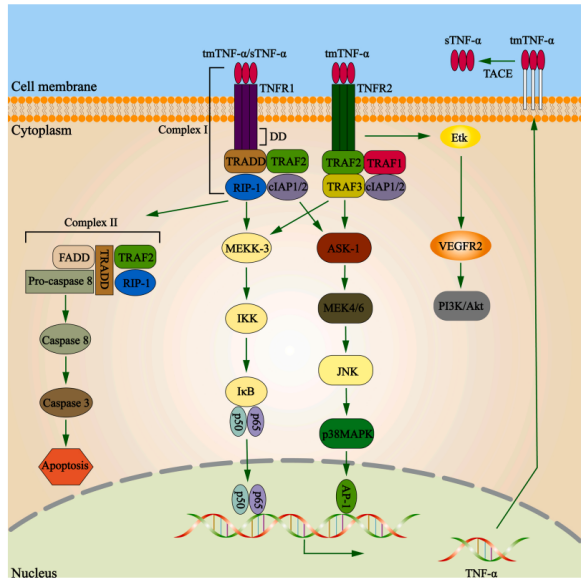

Y04402 Recombinant human TNFα (His Tag)
- Y04402
- 东抗生物
- 江苏省南通市
- 现货
- 按需定制
- 议价
- 2022-10-20 10:28:15
江苏东抗生物医药科技有限公司

背景介绍(Background):
This protein is a multifunctional proinflammatory cytokine that belongs to the tumor necrosis factor (TNF) superfamily. This cytokine is mainly secreted by macrophages. It can bind to, and thus functions through its receptors TNFRSF1A/TNFR1 and TNFRSF1B/TNFBR. This cytokine is involved in the regulation of a wide spectrum of biological processes including cell proliferation, differentiation, apoptosis, lipid metabolism, and coagulation. This cytokine has been implicated in a variety of diseases, including autoimmune diseases, insulin resistance, psoriasis, rheumatoid arthritis ankylosing spondylitis, tuberculosis, autosomal dominant polycystic kidney disease, and cancer. Mutations in this gene affect susceptibility to cerebral malaria, septic shock, and Alzheimer disease. Knockout studies in mice also suggested the neuroprotective function of this cytokine. [provided by RefSeq, Aug 2020].
Tumor necrosis factor (TNF, previously referred to as TNF-α) is a pleiotropic cytokine involved in the pathogenesis of a range of physiological processes that control inflammation, anti-tumor responses, and immune system homeostasis. TNF-α are mainly produced and secreted by immune cells, but they are also secreted by IVD cells. TNF-α is primarily produced as transmembrane TNF-α (tmTNF-α), a type II transmembrane protein arranged in stable homotrimers. Then, the metalloprotease TNF-α-converting enzyme (TACE) cleaves tmTNF-α into sTNF-α (a soluble form). TmTNF-α and sTNF-α are both biologically active. TNF-α elicits its effects via two distinct receptors: TNFR1 and TNFR2. TNFR1 can be activated either by tmTNF-α or sTNF-α, while TNFR2 is activated mainly by sTNF-α. TNFR1 appears to be the core mediator in TNF-α signal transduction due to its constitutive expression in most cell types. TNF-α activates TNFR1 and forms two different TNF signal complexes: complex I has an anti-apoptotic effect, while complex II induces apoptosis. Conversely, TNFR2 mainly exists in immune cells and can be highly regulated, revealing it to be capable of regulating immune function. TNFR2 activation is considered anti-apoptotic due to the absence of an intracellular death domain. The TNFR1 and TNFR2 extracellular domains can be cleaved and released from the surface of the cell into soluble forms, neutralizing the role of TNF-α.

图 TNF-α的信号通路
制剂(Formulation):
Lyophilized from 0.22 μm filtered solution in PBS,5%mannital,0.01% Tween80 pH7.4.
质量控制(Quality Control):
Purity: ≥ 95% as determined by reducing SDS-PAGE.
Endotoxin: < 0.1 EU/ug as determined by LAL test.
保存(Storage):
Use a manual defrost freezer and avoid repeated freeze - thaw cycles.
12 months from date of receipt, -20 to -70℃ as supplied.
1 month, 2 to 8℃ under sterile conditions after reconstitution.
6 months, -20 to -70℃ under sterile conditions after reconstitution.
FOR RESEARCH USE ONLY
参考文献:
[1] Wang Y, et al. 2020. Biomed Pharmacother. 131:110660.
[2] Mehta AK, et al. 2018. Cytokine. 101:14-18.













